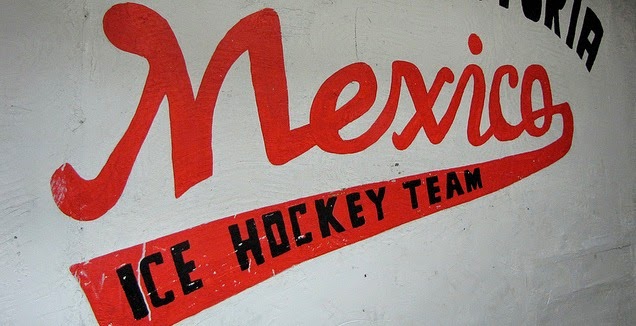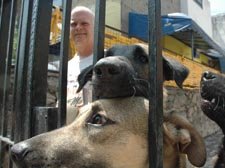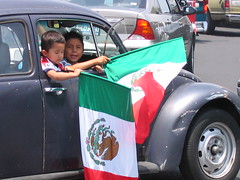
Photograph by : D. Agren
Weaving sustains the meager economy of Tlamacazapa, Guerrero. Virtually all of the town’s residents either make or peddle palm-leaf baskets. It takes Vicente Procopio at least two days to weave a large basket, which he later sells on the street in Mexico City’s San Angel district.
Story by : David Agren
Fernando Lopez’s hands move so quickly while weaving a garbage can-sized palm-leaf basket they almost dissolve into a blur. It takes two full days to craft a large basket at his single-room home made of corn stalks with a tar-paper roof in Tlamacazapa, Guerrero, a remote pueblo in the rugged hills near the tourist town of Taxco. After finishing several pieces, he carts his merchandise to nearby Cuernavaca. Each large item fetches up to 250 pesos.
“Sometimes I make sales, other times not,” he said, sitting on an overturned bucket in a smoke-filled hut next to his milpa (cornfield), a large root smoldering in the corner to cook food.
Virtually the entire adult population of Tlamacazapa, like Lopez, either weaves baskets in hillside shacks or sells baskets in Mexico’s major cities. The cottage industry sustains the town of approximately 6,000 residents, but just barely. Tlamacazapa endures on the fringes of Mexican society; an isolated village populated by Nahuatl Indians in one of Mexico’s poorest and most corrupt states, where local caciques (strongmen) have long laid down the law and development is only gradually arriving. Vices and violence are common; ill health is rife.
Lopez’s story is fairly typical. He grew up amid violence and squalor. A good-natured and gentle man with a thick mop of black hair and a mustache, he sells what he and his family weaves. When not weaving, he works a milpa during the rainy season, tilling the thin soil with a hoe. Its modest bounty keeps his family fed. He lives with his wife and two daughters in Tlamacazapa. His two sons peddle bracelets full-time in Cuernavaca. Several of his children died as infants.
He learned weaving from his father, who used to drink heavily and beat Lopez’s mother. She died when Lopez was 14. His father passed on a few years later.
“He had his vices,” Lopez, who turns 50 on June 10, said in a matter-of-fact manner.
“I used to really like working with my father.”
Unable to produce a legal document for his childhood home, Lopez and his five siblings were tossed from their family’s land after their parents’ deaths. Many years later, he gained title to the vacant plot on the outskirts of town, where he now grows corn. Most diets in Tlamacazapa consist of little more than tortillas and salt. Meat and eggs are luxuries.
Many in Tlamacazapa regularly go hungry; Lopez and his family seldom eat three meals a day. Some residents exchange baskets for food, usually on poor terms. Operatives from Mexico’s political parties take advantage of the situation come election time, trading
despensas (giveaways of food, building materials and sometimes cash) for votes.
“I’m not going to vote,” Lopez declared, saying the entire despensa scheme turned him off of the electoral process. A short time later he said he might support the Democratic Revolution Party (PRD).
Along with widespread poverty and malnutrition, water problems are rampant. Arsenic and lead contaminate the town’s wells, which dry up as the spring dry season drags on. During the spring months, town residents, toting used 18-litre glue and oil cans, hike several times a day to a well high above Tlamacazapa to draw water. Towards the end of the dry season, a child is lowered deep into the lone well with water to fill the villagers’ cans.
The new PRD state government recently installed a water pipe, but it carries fluid from a contaminated source – and only once a week. Another water pipe also exists; corrupt officials, however, charge high fees to access it. Bottled water is too expensive for most households.
Tlamacazapa also lacks adequate sanitation. Animals live in the streets; dung and debris litter the steep roadways. A Canadian charity started constructing dry latrines, which turn waste material into fertilizer. Some locals apparently sleep in the small buildings to keep dry during the rainy season.
Although living in an inhospitable spot nearly three-hours drive south of Cuernavaca, the local population persists and centuries-old customs are kept alive by the virtual isolation. Many of the women in Tlamacazapa still only speak Nahuatl, an indigenous tongue, and wear traditional costumes, consisting of skirts, sandals and colorful shawls. Trips to the doctor are rare; the local
curandera (healer) is frequently called upon.
The isolation began in the 1500s shortly after the Spanish arrived. Legend has it the Indian population of Taxco fled into the hills to escape Hernan Cortes’ cruelty, settling on a mountainside they dubbed Tlamacazapa, which in Nahuatl means, “People of fear.” The basket-weaving industry reputedly took hold shortly thereafter, but no one knows its exact history. According to Lopez, the locals originally made
petates (coarsely-woven mats).
The isolation lasted until the first half of the 1900s, when a bumpy road connecting Tlamacazapa with the outside world was finally constructed. Electricity – enough to barely power a small appliance in the average customer’s home – and a few telephone lines also arrived.
“The people never used to leave,” Lopez said.
Nowadays, many men from the town fan out across Mexico, hawking baskets of all shapes and sizes. Prices depend mainly on the distance the sellers travel and the basket size. The women stay behind, producing additional baskets and maintaining households.
Compared to some of his peers, Lopez sticks pretty close to home. On an average weekend, he sells between one and three baskets in Cuernavaca. Foreigners sometimes take home baskets, but “Pochos,” Mexicans back visiting from the United States, purchase more.
“They’re good customers,” he commented. “They pay well.”
Foreigners buy too, “But only when they’re on vacation.”
When working in Cuernavaca, he crashes in a room rented by his sons.
In addition to haggling with stingy customers, Tlamacazapa vendors like Lopez often battle with unscrupulous local officials, who sometimes demand exorbitant fees for permits and confiscate merchandise when payment isn’t forthcoming.
“Sometimes they seize our merchandise and remove it from the area,” he explained.
Buyers frequently travel up the rocky roadway dotted with political posters, roadside crosses and impromptu garbage dumps between Tlamacazapa and Buenavista, Guerrero (another road runs to Taxco, the municipal seat), but they seldom offer fair prices. Lopez occasionally sells to the middlemen, but only when desperate.
“Sometimes if you need food, you’ll sell,” he said.
According to Lopez, “The first time a buyer comes he offers a fair price.” But with each subsequent visit, the prices become less generous. A typical buyer offers only 80 pesos for a large basket. The palm leaves needed for weaving a typical basket often cost the same amount.
To save money, Lopez and his fellow vendors sometimes forgo taking a 20-peso combi ride to Buenavista or Taxco, instead trekking three hours along a mountainous path, which connects the town with a major highway junction.
“Sometimes I walk, hauling my merchandise, when I don’t have enough bus fare,” Lopez explained.
Additionally, Lopez often scours the nearby countryside for palm leaves to save a few pesos. The palm leaves are cut and painted prior to weaving. Each piece is methodically incorporated into the design.
Although it’s a tough way to eke out a living, Lopez seldom complains. He cheerfully recounted stories of living in Tlamacazapa and his adventures selling baskets during a recent visit by foreigners. His daughter Erika, a bubbly 14-year-old with a bright smile and playful nature, acted as a guide. Like many teenagers, she stopped attending school, even though the town has a telesecundaria (a junior high school with instruction via television). Most Tlamacazapa residents marry young.
And the vast majority will continue weaving baskets for the foreseeable future. As Lopez put it: “Here, we don’t have any other work except for the baskets.”
From the Guadalajara Reporter






